| 23 Rows |
|---|
 Agate
This is a gorgeous slab of Powell Butte (Maury Mountains, Crook County, Oregon) plume agate. The larger image (bottom row) shows backlit portions. Thanks to Sara Lynn Schroeder's auction on eBay for the specimen! | |
|
 Agate
Agate is the name given to cryptocrystalline quartz whose color varies in either circular or dendritic patterns (onyx is the other, banded variety - note that "onyx" can also refer to cryptocrystalline multicolored banded calcite; it's best to refer to this as "Mexican onyx" or "onyx marble"). This slab looks like the Texas Plume variety from the Canadian River watershed in Texas. There are innumerable names for the different agates, most of them based on localities. Thanks to Frank Elsen for the specimen! |
|
 Agate
A tumbled miniature of red and yellow agate from Utah. Thanks to Lisa's (Nature's Alley) auction on eBay for the specimen! | |
|
| Row 2 |
|---|
 Agate
A tumbled miniature of gray and white agate from Mont-Lial, Gaspe Peninsula, Québec, Canada. Thanks to Richard Valade's auction on eBay for the specimen! |
|
 Amethyst
A chunk of amethyst that I got on one of my vacations to Florida - there were tables full of amethyst! |
|
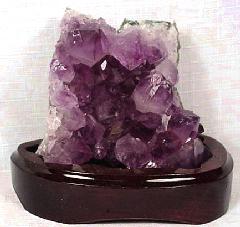 Amethyst
This is a beautiful natural piece of Brazilian amethyst. Thanks to Peter Biskup's (Peter Biskup - Gems & Minerals) auction on eBay for the specimen and the image! |
|
| Row 3 |
|---|
 Amethyst
Part of this specimen is the usual hematite-included "red" amethyst typical of the Thunder Bay region in Ontario, Canada - the remainder is the new "starburst" variety found only in the Current River district. Thanks to Marty Lewadny at CrystalEnthusia (formerly Crystal Variations) for the specimen and the image! | |
|
 Amethyst
These should be with my gemstones - stalactical amethysts around an agate core from Artigas, Uruguay. The larger image includes the second, more purple, specimen. Thanks to Shava J. Spector-Simmons' auction on eBay for the specimens! |
|
 Amethyst
The amethysts from Piedras Parado, Mun. de Profesor Rafael Ramirez (AKA: Las Vigas), Veracruz, Mexico are known for their pale lavender color - this miniature has gemmy micro epidote crystals as well. Thanks to John Lee's auction on eBay for the specimen! |
|
| Row 4 |
|---|
 Amethyst
Pale amethyst crystals in rhyolite comprise this miniature from the Topaz Mountain Amphitheater, West Wall, Juab County, Utah. Thanks to Lou Stoat's auction on eBay for the specimen! |
|
 Amethyst
The amethysts from the Muhshquash mines near Thunder Bay, Ontario, Canada are chunky, cloudy, and have red and green included areas. Thanks to Aaron Kelman's auction on eBay for the specimen and the images! |
|
 Ametrine
Ametrine is the common name given to quartz that is a combination of amethyst and citrine - these specimens are probably from Brazil. Thanks to Frank Elsen for the specimens! | |
|
| Row 5 |
|---|
 Smoky Amethyst
Smoky amethyst occurs when amethyst is naturally irradiated - this small cabinet piece is from the Hallelujah Junction (Krystal Tips Mine) quartz locality, Lassen County, California / Peterson Mountain Range, Washoe County, Nevada area. Thanks to Joan Hite's (Krystal Tips Mining) auction on eBay for the specimen! |
|
 "Beta Quartz"
Actually (alpha) quartz after beta quartz, this beautiful thumbnail intergrown pair of "beta quartz" crystals is from the 2000 find at the 1st Sovietski Mine, Dal'negorsk, Primorskiy Kray, Russia. As in all "beta" quartz, the prisms are absent. My eisenkiesel speciemn is also "beta" quartz. Thanks to Bob & Marlene York's auction on eBay for the specimen and the image! | |
|
 Chalcedony
A beautiful frosty large cabinet specimen of chalcedony from Vani, Nasik, India. Thanks to Dave & Liz Douglass' (Douglass Minerals) auction on eBay for the specimen and the images! | |
|
| Row 6 |
|---|
 Chalcedony, var.
Aventurine
Chalcedony with microscopic mica flakes (typically green fuchsite) is called aventurine. Traditionally green, it now appears on the market in various colors, see here for "blue aventurine". This miniature has a couple of different inclusions. Thanks to Thomas Anthony's auction on eBay for the specimen! |
|
 Chalcedony, var.
Chrysoprase
Chrysoprase is the beautiful green cryptocrystalline (chalcedony) variety of quartz - the green is caused by inclusions of willemseite, a nickel-bearing talc. This specimen's from the famous Marlborough Mine in Queensland, Australia. Thanks to SoCal Nevada's auction on eBay for the specimen and images! | |
|
 Chalcedony,
var. Myrickite
Myrickite's the common name given to chalcedony with cinnabar inclusions - this miniature is from
the Manhattan Mine (mercury) in Knoxville, Napa County, California. Thanks to Alan Fisk's auction on eBay for the specimen! |
|
| Row 7 |
|---|
 Citrine
Citrine, the yellow to brown variety of quartz., is fairly rare. Most "citrine" is heat-treated amethyst. |
|
 Citrine
A dark golden brown drusy citrine from Tucson, Arizona. Thanks to Cheryl & Michael Munson's auction on eBay for the specimen! |
|
 Citrine
This is a beautiful cluster of clustered deep amber citrine from the 2001 find in Rio Grande, Brazil. | |
|
| Row 8 |
|---|
 Citrine
A cute thumbnail of light yellow citrine from Minas Gerais, Brazil. This one and the new Rio Grande citrine are probably the only true citrines I have. Thanks to the Carnegie Natural History Museum Store for the specimen! |
|
 Citrine
A citrine twin and fragments, probably from Brazil. Thanks to Frank Elsen for the specimens! |
|
 Cristobalite
Cristobalite, one of the quartz polymorphs, usually occurs in microscopic crystals. Occasionally, those crystals aggregate into radial clusters or spherules, as in this thumbnail of cristobalite in obsidian from Beaver County, Utah. These often appear as "snowflakes", hence the varietal name snowflake obsidian. Thanks to Mully Vinukur's auction on eBay for the specimen! |
|
| Row 9 |
|---|
 Cristobalite
A superb and fascinating thumbnail of cristobalite crystals on a pseudomorphed hematite garnet from the Thomas Range of Utah. Cristobalite can also be formed artificially by calcining diatomaceous earths, which are used as filtering media by the brewing industry and by other high-temperature processing of silica-based items, thus (unfortunately) adding (the inhalable dust) of it and tridymite to the list of hazardous carcinogenic substances. Thanks to Walter Mroch's auction on eBay for the specimen! |
|
 Cristobalite
An excellent rare miniature of an obsidian matrix with a large open bubble lined with cristobalite and some small sharp well terminated fayalite (olivine) crystals (larger image, center) attached. The cristobalite is formed when obsidian devitrifies over time. Large cristobalite-filled bubbles like this are relatively rare - the more typical occurence is shown in my first specimen. From the now-closed site at Coso Hot Springs, Inyo County, California. Thanks to Anthony Jones' auction on eBay for the specimen and the image! |
|
 Eisenkiesel
Eisenkiesel (the name is German for "iron and flint") quartz from the Florence Mine near Egremont, Cumbria, England. The red coloring is due to hematite inclusions and the "beta" quartz crystals themselves ride on specular hematite over massive hematite. There's also a scattering of millimeter-sized colorless fluorites (larger image, bottom). Thanks to Chris Korpi at Pangaea Minerals for the specimen! |
|
| Row 10 |
|---|
 Quartz Geode
Every rockhound's got geodes - here's one of mine. |
|
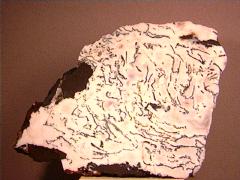 Medfordite
A matte-finish 6"-diameter slab of medfordite (found only near Medford (Eagle Point, Jackson County, Oregon in a now-closed location, hence the name) - massive milky quartz (or white chalcedony) with dark green iron-based (probably a phosphate) inclusions. Some of the quartz has agatized (the translucent areas of the backlit image, larger image, bottom right). It also looks like what jewelers call "tree moss agate" though I haven't seen a similar slab and the cabochons I've seen don't look the same. Thanks to Larry Blake's auction on eBay for the specimen! | |
|
 Milky Quartz
A large cabinet plate of milky quartz from the 1994 dig at the "Moosup" railroad cut in Plainfield, Windham County, Connecticut. Some of the crystals have clear tips (larger image, lower right). Thanks to Eric Greene's (Treasure Mountain Mining) auction on eBay for the specimen and the images! | |
|
| Row 11 |
|---|
 Milky Quartz
A big! (6-inch) somewhat milky quartz crystal with some transparent parts and a big rainbow (larger image, bottom right). Thanks to Marvin Scwalb's auction on eBay for the specimen! |
|
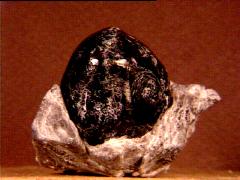 Obsidian, var.
Apache Tear
This miniature Apache Tear (obsidian in a weathered obsidian "perlite" matrix) comes from Superior, Arizona, Ex: Arizona Mineral Company. Thanks to Marvin Scwalb's auction on eBay for the specimen! |
|
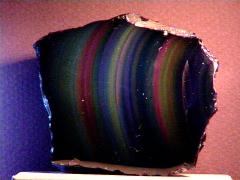 Obsidian, var.
Rainbow Obsidian
A small cabinet polished rainbow obsidian. The rainbow's probably due to interference between trapped microcrystals, though a 2001 paper claims thin-film interference (in Mexican rainbows). I've included it here because it's at least 50% silicon dioxide (the same composition as quartz) - the remainder is inseparable (it's amorphous) oxides. This was very difficult to photograph - please excuse the lighting glints and odd-colored shadows. This one may be from the Glass (Obsidian) Buttes, Lake County, Oregon. |
|
| Row 12 |
|---|
 Opal, var.,
Quincyite
A nice miniature of quincyite (or quinzite opal) from the type locality of Quincy-sur-Cher, Bourges, Cher, Centre, France. The pink color is due to peri-xanthenoxanthenequinones adsorbed or intercalated in sepiolite inclusions in the quincyite. Thanks to Paolo Bracci's auction on eBay for the specimen and the images! | |
|
 Opal, var.,
Ripleyite
Ripleyite, an orange dendritic opal, comes only from British Columbia, probably from the Okanagan Opal Inc. Klinker prospect, near Vernon. Thanks to Michael Toponce's auction on eBay for the specimen and the images! | |
|
 Perlite
Perlite, like obsidian and pumice, is a volcanic glass, typically 70 - 75% silicon dioxide and the remaining majority aluminum oxide. It also contains trapped water and expands upon heating to its melting point, making perlite useful for insulation and other applications. This miniature comes from Globe, Gila County, Arizona. It has a Tony Jones 3/2010 dealer tag and is ex: Collections Will Estavilla and Richard Bates. Thanks to David H. Garske's (MINERALS and MORE) auction on eBay for the specimen! |
|
| Row 13 |
|---|
 Pumice
Like the obsidian above, pumice is also volcanic glass - but it has lots of trapped gases inside and usually floats (this one does!) Thanks to Robert Winfree's auction on eBay for the specimen! |
|
 Rock Crystal
Quartz on both sides of a druse, clear and apparently smoky (although on close examination they're fuzzy black inclusions instead). |
|
 Rock Crystal
Herkimer diamonds from the varietal type locality of Little Falls, Herkimer County, New York - I dug them out myself back in the early '60s. | |
|
| Row 14 |
|---|
 Included Quartz
Rock crystal often has inclusions. left to right
Rutilated quartz - five of the six sides have been cut and polished. When the rutile intersects at 60° angles (as here) it's also called "sagenite". This was one of the first specimens I collected - I think it's from Brazil. Tourmalinated quartz - these two tumbled pebbles have schorl in them. At top right is another rutilated quartz but with much finer and lighter color rutile - it's called "angel hair". The last piece is a Herkimer Diamond with an anthraxolite inclusion. I also have a rutilated quartz cube with angel hair. (Thanks to Jim Coleman's (Jim Coleman Crystal Mines) auction on eBay.) |
|
 Tigereyes
from left to right
Catseye, tigereyes, and hawkseye - the color determines the name (green, yellow to red, and blue respectively. Brown tigereye is referred to as bullseye. The chatoyancy is caused by the same mineral (oriented crocidolite fibers) in various stages of oxidation from blue (unoxidized) through green, yellow, and red to brown (fully oxidized). |
|
 Rock Crystal
A relatively large Herkimer diamond on matrix from Fonda, New York. Hiding in the quartz druse is a very rare pinacoidally-terminated quartz crystal with second-order trigonal faces! Thanks to Eric Greene's (Treasure Mountain Mining) auction on eBay for the specimen! |
|
| Row 15 |
|---|
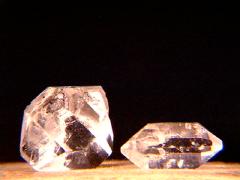 Rock Crystal
There's only a few places where "Herkimer Diamonds" are found - this pair is from above the little village of Jin Kou He in southwest Sichuan Province, China. Thanks to James Bowers for the specimens! |
|
 Rock Crystal
Sometimes there are other inclusions in quartz - this cluster of quartz from the White Mountains, Bishop, California has lawrencite (an iron-nickel chloride) inclusions. Thanks to Chris Korpi at Pangaea Minerals for the specimen! |
|
 Rock Crystal
Hematite is one of the most common inclusions in quartz - this miniature's a brilliant red. Thanks to Robert Kufrovich's auction on eBay for the specimen! |
|
| Row 16 |
|---|
 Rock Crystal
This rock crystal cluster has hematite inclusions as well, only the hematite here is very thin (red) flakes (larger image, middle panel) on the quartz surfaces. The quartzes also have an odd termination asymmetry (larger image, bottom panel). This miniature cluster is from Børgefjell, Nord-Trøndelag, Norway. Thanks to Lars Jorgensen at Geosystems for the specimen! |
|
 Rock Crystal
Small doubly-terminated quartz crystals on matrix from Lierne, Nord-Trøndelag, Central Norway. The extreme closeup (larger image, bottom) shows just how transparent the crystals are - it's difficult to see this one. Thanks to Lars Jorgensen at Geosystems for the specimen! |
|
 Rock Crystal
A hematite-included quartz cluster thumbnail from Calpe, Alicante, Valencia, Spain. Thanks to Carlos Pareja's (PAREJA MINERALES) auction on eBay for the specimen and the image! |
|
| Row 17 |
|---|
 Rock Crystal
A small cabinet specimen of the famous blue quartz (aerinite inclusions) from Malaga, Spain. Thanks to Carlos Pareja's (PAREJA MINERALES) auction on eBay for the specimen and the images! | |
|
 Rock Crystal
The Growth Interference Quartzes from Dal'negorsk, Primorskiy Kray, Russia, occur when the calcite intergrowth is removed - this miniature is very fragile! Thanks to Throwin' Stones's auction on eBay for the specimen and the images! | |
|
 Rock Crystal
Sometimes only a small amount of hematite is present during crystallization - this miniature crossed pair is from Lechang City, Guangdong Province, China. Thanks to Lee & Dana Arbach's auction on eBay for the specimen and the image! |
|
| Row 18 |
|---|
 Rock Crystal
A (lightly) hematite-coated small cabinet cluster of rock crystal from the Wahna area of Pakistan. Thanks to S & F Gem's auction on eBay for the specimen! |
|
 Rock Crystal
A bright yellow small cabinet quartz specimen from Corinto, Araçuai, Minas Gerais, Brazil - usually the yellow (iron oxide) coating is cleaned off before these leave the site. These are often called "tangerine quartz". Thanks to Dave & Liz Douglass' (Douglass Minerals) auction on eBay for the specimen! |
|
 Rock Crystal
A miniature doble-terminated rock crystal with a hydrocarbon inclusion from Sichuan, China. Thanks to Darrel Merke's (Proton Minerals) auction on eBay for the specimen and the images! |
|
| Row 19 |
|---|
 Rock Crystal, var.
Angle Plated Quartz
These odd microcrystalline miniature quartz clusters form as deposits in red clay cracks in upstate (Travelers Rest, Greenville, Pickens and Oconee Counties) South Carolina. A slight amount of the red clay is included, resulting in the light peach color. Thanks to Jenny Rothkopf's auction on eBay for the specimen and the images! | |
|
 Rock Crystal,
var. Aqua Aura
Another fashion trend from a few years ago - rock crystal sputter-coated with gold. Unlike the multicolored titanium quartz, the thickness here is well-controlled to produce this "standard" blue. Note that some "blue quartz" is colored internally, either by mineral particles small enough that they scatter blue light (like the sky) or by mineral impurities such as aerinite. |
|
 Rose Quartz
A rose quartz crystal aggregate from Galileia, Minas Gerais, Brazil - rose quartz rarely forms crystals (the reason is still under discussion) and the Brazilian locales are the only crystal-producing sites known. Crystalline rose quartz is photosensitive so I'm keeping mine in the dark. Thanks to Rob Kulakofsky at the Arizona Mineral Company for the specimen and the image!
Image copyrighted by the Arizona Mineral Company. |
|
| Row 20 |
|---|
 Smoky Quartz
An opaque black smoky quartz - when it's this dark it's often called "morion". There's also some calcite here and there (and it glows white under longwave UV). |
|
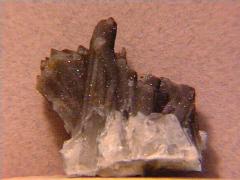 Smoky Quartz
A beautiful miniature of smoky quartz from Mexico - it also has calcite and some millimeter-sized purple fluorites (larger image, bottom). |
|
 Smoky Quartz
A nice miniature of smoky quartz from California. Thanks to Frank Butler for the specimen! |
|
| Row 21 |
|---|
 Smoky Quartz
A brilliant clean miniature of pale smoky (champagne) quartz. Thanks to Martha Crawford's auction on eBay for the specimen! | |
|
 Smoky Quartz
Double-terminated smoky quartz crystals aren't very common - this miniature's from TjalFjellet, Lierne, Nord-Trøndelag, Central Norway. Thanks to Lars Jorgensen at Geosystems for the specimen! | |
|
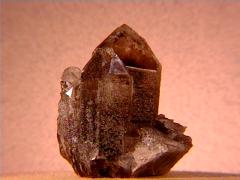 Smoky Quartz
More smoky quartz from Lierne, Nord-Trøndelag, Central Norway - this cluster has a nice phantom in the main crystal. Thanks to Lars Jorgensen at Geosystems for the specimen! |
|
| Row 22 |
|---|
 Smoky Quartz
This smoky cluster from the same locale is lighter in color so the phantoms are more easily seen. Thanks to Lars Jorgensen at Geosystems for the specimen! | |
|
 Smoky Quartz
An excellent small cabinet smoky quartz crystal from Nova Belém in Minas Gerais, Brazil. Its habit is the rare Tessin - a steeply-angled termination rathet than the more typical shallow one. Thanks to Eric Greene's (Treasure Mountain Mining) auction on eBay for the specimen and the images! | |
|
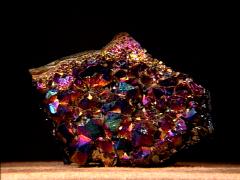 Titanium Quartz
This is one of the recent jewelry fashions - titanium and niobium sputtered onto quartz (probably amethyst) points. The thickness of the layer is deliberately left uncontrolled; thus the varied colors. |
|
| Row 23 |
|---|
|
|
 Tridymite
A thumbnail cluster of bluish-white tridymite from the Thomas Range of Utah. Tridymite is one of the quartz polymorphs. Thanks to Walter Mroch's auction on eBay for the specimen and the image! |
|
|




![]()
![]()